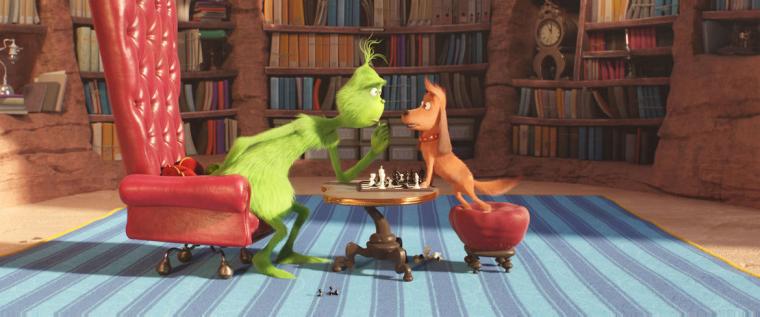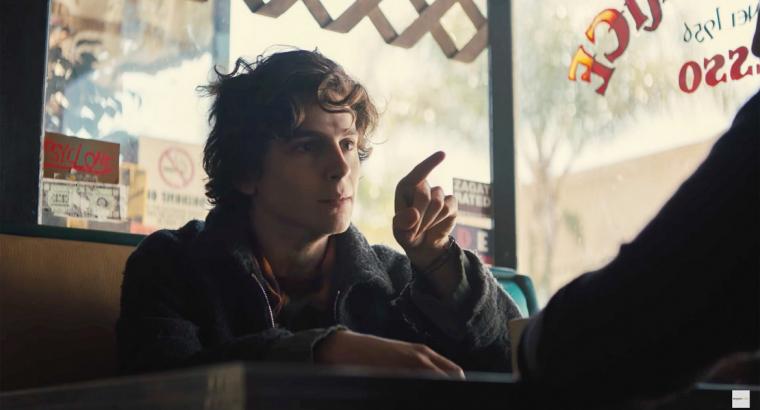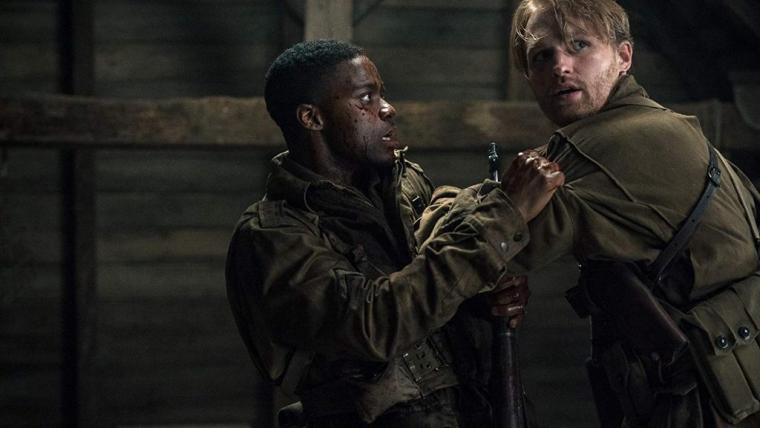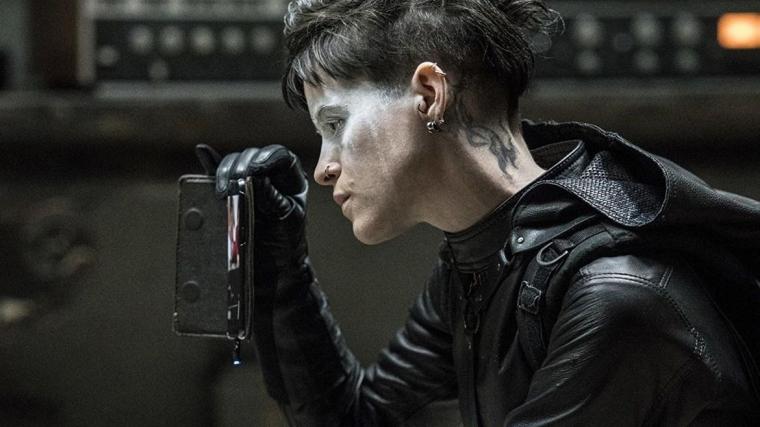
DR. SEUSS' THE GRINCH
Before I'm accused of being one myself, let me state up front that Dr. Seuss' The Grinch – the latest retelling of the good doctor's How the Grinch Stole Christmas – has quite a few things going for it (Happy Holidays!), even if they're eventually outweighed by the things going against it. (Bah, Humbug!)
The morals in this timeless holiday tale are, of course, unimpeachable, as are the movie's computer-animated visuals; even when the narrative is merely yawning along, there's always something shiny, sparkly, zippy, or demonstrably grand to stare at. (I was particularly wowed by the enormous pipe organ that this movie's sad-bastard Grinch employs for a cover of Eric Carmen's “All by Myself.”) Young performers Cameron Seely and Tristan O'Hare provide delightful energy as Cindy-Lou Who and her best pal Groopert, Rashida Jones and Kenan Thompson offer additional vocal amusement, and if you listen carefully, you'll even be treated to the magical sing-song of Angela Lansbury for all of 10 seconds. The Grinch's eternally peppy puppy Max is adorable, as is a behemoth reindeer named Fred. The 1966 animated TV special's familiar “Welcome, Christmas” tune, with its beautifully unfathomable Seuss-ian lyrics (“Fah who for-aze, dah who dor-aze … !”), is given a lovely reprise. A shrieking mountain goat nails his laughs on all three of his shrieks. And while the film, in an animated-comedy rarity, largely eschews modern-day references, the fastidiously designed town of Whoville does boast a grocery whose store name made me chuckle: Who Foods. If that's indeed an intended play on Whole Foods, it's a pretty clever gag. Of course, you could also remove the “l” and the “e” from “Noel,” and what you'd be left with is “No.”
Unfortunately, a capitalized “No” is what I thought in regard to far too much of directors Yarrow Cheney's and Scott Mosier's seasonal outing, which runs a tidy 85 minutes yet still manages to feel overlong. No to the resolutely unmemorable, Americanized readings of Grinch portrayer Benedict Cumberbatch, who sounds so fixated on hitting his hard “r”s that he forgot to be funny. No to the predictable and unnecessary backstory, with accompanying flashbacks, detailing what life events made a young Grinch turn mean, and No to the film's conception of him, at age 53, as less nasty than merely depressed and lonely and self-pitying. (“All by Myself”? Really?) No to the Grinch's out-of-character habit of apologizing to poor, put-upon Max even before the furry green grump's heart stops being two sizes too small. No to the inevitable hip-hop update on “You're a Mean One, Mr. Grinch” (performed by Tyler, the Creator) and the equally expected scenes of manic slapstick scored by an overqualified Danny Elfman. No to our hearing Angela Lansbury's voice for only 10 seconds. And No to the mostly uninspired voice-over narration delivered by Pharrell Williams, with screenwriters Michael LeSieur and Tommy Swerdlow at one point point choosing to rhyme “idea” with “idea.” So Dr Seuss' The Grinch does have a couple of ideas. Avoiding the film isn't an altogether bad one.

BEAUTIFUL BOY
At the ripe old age of 22, Timothée Chalamet possesses a charisma that practically bleeds off the screen. It may be unfair to compare him to James Dean, who died when he was only two years older than Chalamet is now. But already, the Call Me by Your Name star and Lady Bird stealth weapon projects an astounding capacity for emotional truth and character-revealing idiosyncrasies in the manner of the Rebel without a Cause legend, and he floods his roles with so much specific invention and gut-level honesty that whenever he's in sight, you can't take your eyes off him. All of that makes him ideal casting for director Felix van Groeningen's Beautiful Boy, in which Chalamet portrays a struggling drug addict who keeps vanishing in front of your eyes. Chamalet is so complete a presence that when his troubled protagonist Nic Sheff slips further and further away from us, and from his deeply concerned father David (Steve Carell), it feels like we're losing both the character and the actor himself, who has the rare gift of making an audience feel not just sympathetic, but protective. Viewed overall, van Groeningen's film is an effective melodrama. If Chalamet's on-screen, it's more accurately a wrenching one.
Despite being based on both David's memoir Beautiful Boy and Nic's own memoir Tweak, there isn't much to van Groeningen's and co-screenwriter Luke Davies' narrative, which can simply, if rather crudely, be boiled down to recovery/relapse/repeat. (Add several more “repeat”s and you get to the film's two-hour running length.) And while many individual images and sequences are shattering, the movie is less successful in its handling of the Big Picture, with Amy Ryan (as Nic's mom) and Maura Tierney (as his stepmom) given unfortunately short shrift despite some affecting moments, and the chronological leapfrogging leading to some distracting time-line confusion. (At one point, we're told that Nic has been away from his family for more than 14 months, yet when he reunites with his golden-haired siblings, they don't look a day older than the five and six years they previously appeared to be.) Yet as a primer on the precise nature of drug addiction that's also a father-and-son love story, the film works, and frequently works spectacularly well.
Carell's David doesn't merely want to know why his smart, funny, seemingly happy child became in thrall to the effects of crystal meth; he wants to know how, and the film is superbly detailed in David's attempts to confront the truth through factual study, expert opinion, and even his own experiment with the drug. (Though in fine dramatic form throughout and exceptional when acting with Chalamet and the film's pre-teen children, Carell is at his best when David is trying to wave away the power of his crystal meth high through sheer determination.) Davies and van Groeningen, meanwhile, write magnificent scenes of familial discord for their male leads, especially in one tortured diner conversation and the angry, achingly sad encounter in which David, astutely, accuses Nic of stealing his baby brother's life savings of eight dollars. Like the busily eccentric yet thematically resonant soundtrack that features Nirvana, Bowie, Lennon, Perry Como, grand opera, and Fiddler on the Roof's “Sunrise, Sunset,” the roiling emotions in Beautiful Boy are all over the place. Thanks to Carell and the riveting Timothée Chalamet, it's a beautiful, if heartbreaking, place to be.

OVERLORD
A gross-out horror flick can never have quite enough Nazi zombies for my tastes, and so my biggest disappointment in the World War II splatter-fest Overlord came from it featuring only a handful of recognizably SS zombies to root against, with the rest of the decaying undead arriving in the forms of innocent French civilians and American G.I.s. That being said, this gory outing by director Julius Avery, with J.J. Abrams credited among its producers, still delivers a more-than-fair amount of ghoulish fun.
After a harrowing prelude involving a quickly descending plane rife with bullet holes and puke, Avery's film sends an enjoyably stereotypical team of combatants – among them a nervous newbie (Jovan Adepo), a grizzled commander (Wyatt Russell), and a wisecracking gum-chomper (John Magaro) – behind enemy lines in the hopes of destroying a radio-jamming device mere hours before D-Day. Complicating matters is the device's locale at the top of a church tower in a Nazi-occupied, heavily fortified French village. Really complicating matters are the unholy experiments of the Josef Mengele-esque Dr. Schmidt (Erich Redman), whose plan to create an unkillable Nazi force lies in a gloopy serum that acts like the adrenalin that revitalized Uma Thurman in Pulp Fiction – if, upon receiving the injection, Uma instantly transformed into the Brundlefly. It's all expectedly icky and expectedly silly, and it's hard to know how to take the recklessly stupid decisions routinely made by our hero, given that Adepo's soldier witnesses exactly what Schmidt's serum does to its victims and still decides that injecting it into a fallen comrade's leg is the best way to revive him. (Spoiler alert: It ain't.)
Yet the easily diverting, frequently gripping Overlord remains a vicious good time. Adding Mathilde Ollivier as the American troops' handy-with-a-firearm host and the endearing Gianny Taufer as the woman's little brother, the film is uniformly well-acted, with Adepo (Denzel Washington's bitter son in Fences) an empathetic audience surrogate and the usually laid-back Wyatt Russell finally demonstrating some of his dad Kurt's action-hero prowess. Amidst the bevy of exploding squibs and monstrous half-faces, there's a particularly satisfying, far subtler throwaway bit involving a strategically placed hand grenade and a bit of duct tape. And for a genre in which those playing Nazis are forever required to overact, Danish performer Pilou Asbæk overacts to the glorious hilt, emerging as a four-star loon even before he's spitting out invective with half his jaw gone. At its best, Overlord suggests what we'd get if Spielberg re-fashioned Saving Private Ryan as Dawn of the Dead.

THE GIRL IN THE SPIDER'S WEB
The Swedish computer hacker, avenging angel, and pierced Goth icon Lisbeth Salander first appeared in author Stieg Larsson's 2005 novel The Girl with the Dragon Tattoo, and went on to be featured in two additional Larsson thrillers and two more (to date) written by David Lagercrantz. A friend of mine who devoured all five Salander books described the Lagercrantz efforts as “Larsson without Larsson,” and as I haven't read them myself, I'm in no position to argue. I am, however, willing to call the new film adaptation of Lagercrantz's The Girl in the Spider's Web “Fincher without Fincher,” because it's just familiar enough to suggest David Fincher's hit version of Dragon Tattoo from 2011, but without its style or haunting star turn by Rooney Mara. In other words, it's just a lot of chilly Swedish locales and hole-ridden plotting that finds Salander – now played by Claire Foy – deprived of nearly all her individuality and turned into a generically pissed-off action heroine stuck in a series of increasingly dull and dopey spy games. How can a movie find room for Lakeith Stanfield, Stephen Merchant, Blade Runner 2049's Sylvia Hoeks, Mindhunter's Cameron Britton, and Phantom Thread's Vicky Krieps and still make you actively, hopefully stare at the auditorium's exit sign?
There are occasional nods to the perversions of Dragon Tattoo, as when Salander becomes encased in a vacuum-sealed leather contraption that makes her resemble a writhing black jelly bean. Yet from its first minutes in which Salander saves the life of an abused wife and exacts vengeance on the woman's husband – the characters consequently vanishing from the narrative entirely – director Fede Alvarez's Spider's Web is so by-the-book Bond that it may as well open with a soaring pop anthem by Adele. In this adventure, Salander is recruited to track down a stolen computer program that gives its user access to the world's nuclear-launch codes, a device that NSA agents, Swedish intelligence, and the requisite baddies – one of them a Salander relative dressed like an X-Men villain – want desperately for themselves. This being a faux 007, that means a lot of surveillance, shoot-outs, and perilous close calls in which everyone tries awfully hard to kill our lead unless they actually can, at which point someone inevitably starts monologuing. But while most of it is staged with competence, none of it is presented with any storytelling excitement or discernible imagination. And while Foy, with her expressive big eyes, does her best to provide much-needed soul, there's nothing she can do to disguise the blandness of this film's conception of Salander. She may not be as superfluous here as journalist Mikael Blomkvist (Sverrir Gudnason, taking over for Daniel Craig), but to even consider superfluousness in relation to Lisbeth Salander feels like a crime against Larsson. And Fincher. And us. This past spring, Foy starred in the Steven Soderbergh chiller Unsane. The Girl in the Spider's Web is all too sane.

VOLCANOES: THE FIRES OF CREATION
Generally speaking, the 45-minute running lengths for National Geographic documentaries at the Putnam Museum & Science Center feel just right for their subjects and, I'm guessing, the attention spans of their predominantly grade-school viewers. But three quarters of an hour, for me, was nowhere near the amount of time I wanted to spend at the venue's new Volcanoes: The Fires of Creation, because I could've happily watched this thing all day long. Directed by Michael Dalton-Smith and focusing on the intrepid work of Nat Geo's intensely brave photographer Carsten Peter, the movie provides an impressive share of factoids: how the majority of the world's volcanoes are found underwater; how 500 million people currently live within active volcanoes' probable paths of destruction; how volcanic ash is actually a tremendous boon to ecosystems, and was principally responsible for the glorious expanse of Africa's Serengeti plains. Yet as fascinating as these narrated tidbits were, I might've left Volcanoes just as satisfied if it were a silent film, or at least one wholly free of words, given that the 3D sights on display left me less fascinated than thunderstruck.
We're shown a number of the National Geographic photos that have earned Peter international acclaim, with his up-close, 2001 capturing of Italy's Mt. Etna mid-eruption an especially astounding shot. Dalton-Smith's film also, wisely, shows the terrifying means by which Peter obtains his images, which involve traversing thousands of feet down nearly vertical surfaces and praying that volcanic debris isn't blasted into your face. (Pair Volcanoes with the fantastic rock-climbing doc Free Solo – currently still playing at Iowa City's FilmScene – and you'd have a vertigo-producing double-feature for the ages.) But the Putnam's latest is overflowing with similarly thrilling, eye-popping astonishments. There's incredible footage of the carefully preserved remains from Mt. Vesuvius' eradication of Pompeii, as well as the 2010 devastation in Indonesia and a recent eruption at Japan's Mount Kirishima. The most significant amount of screen time, however, is reserved for Hawai'i's Iower Puna eruption on the Kilauea volcano this past May, and the sights of its fiery explosions and curdling molten lava demolishing trees, houses, and entire communities are delivered with appropriate horror and awe; you're amazed anew that, somehow, not one human life was lost in the months-long volcanic event. Informative, breathtaking, and beautiful in equal measure, Volcanoes: The Fires of Creation is – pardon the lava-centric pun – a blast, and chock full of randomly captivating bits, such as the volcanic rocks that landed roughly a mile away from their former active-volcano home. “If every rock tells a story,” says narrator Ross Huguet, “imagine what these rocks would say.” I'm betting it'd probably be something like “A-a-a-a-a-a-a-a!!!”










